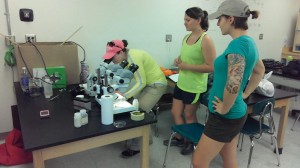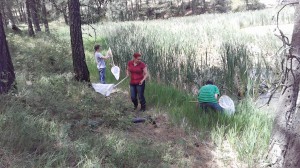Experts in vector biology, surveillance, control and vector-borne diseases are getting older. Whilst attending a number of US vector control and society meetings over the years, I could not help but notice that most mosquito control professionals are getting close to retirement. Therefore, there is a critical need for a steady supply of young professionals to run vector surveillance and control operations, and conduct research on vectors and vector-borne diseases.
While there is a cadre of brilliant young researchers in the field, most of the ones I know work in academia and so there is a shortage of skilled workers for these critical jobs in the field. In addition, there is a lack of awareness among policy-makers and the general public in the US about disease vectors, vector-borne diseases, and the importance of combating them. This is further complicated by issues surrounding pesticide usage which leads to low and unpredictable funding at local and state levels.
The best way to combat both of these problems is to educate students in disease ecology as early as possible through hands on learning at the undergraduate level. As part of my new position as Assistant Professor of Biostatistics at the Department of Biology at Eastern Washington University (https://www.ewu.edu/cshe/programs/biology), I had the opportunity to teach a class named Biological Investigations this summer. The purpose of this class is to expose undergraduate students in Biology to the scientific method, how to read scientific articles, help them to conduct an experiment on their own, analyze their results, and teach them science communication. The class ran only through 4 weeks. The theme of the class and the research projects is up to the instructor, and I chose disease ecology.
The nine students, listed below as coauthors, selected 1 of 3 projects available and conducted their projects in teams at and with the assistance of the Turnbull National Wildlife Refuge. As part of their assignment in science communication, I asked them to draft one paragraph each for this post to describe their project and their experience. To my delight, each of the teams produced meaningful, significant results from their project and the excerpts below demonstrate how meaningful research experience in vectors and vector-borne diseases is indeed possible in such a short amount of time. The students not only had fun, but learned a lot about the topic of their projects:
Ticks: Lurking on your nature trail (by Jennifer Headley, Naomi Matson and Diana McSwain)
There are many misconceptions about what microhabitats questing ticks prefer. Prior to this experiment we would have expected that wandering away from known trails into undisturbed vegetation would increase the likelihood of tick encounters. Using sample data collected from three 100 m transects by the dragging method, an ANOVA One-Way test (p < 0.003048) demonstrated that ticks are found more often along wildlife trails than in undisturbed grassland or forested areas. Tukey HSD’s revealed that the wildlife trail transect had a significantly higher density (p<.01) when compared to the grassland transect, as well as a significantly higher density (p<.05) than the forest transect.While sticking to the trail and avoiding surrounding brush may seem like the best way to avoid getting bitten by a tick, in reality your best defence against tick bites is to dress appropriately and always take the time to thoroughly check yourself for ticks after exposure to the outdoors.
Behavioral Responses of Culex Mosquito Larvae to Changes in Diet (by Leann Ikeda, Amy McGowan and Stanislav Tsarevskiy)
According to the American Mosquito Control Association, “over one million people worldwide die from mosquito-borne diseases every year” (2013). The rates at which these diseases are spreading globally are increasing due to the growth in tourism and international air travel. Knowing what types of food adult mosquitoes and larvae thrive on or avoid could bring researchers one step closer to controlling this issue. Our experiment found that Culex mosquito larvae responded differently to being fed different sources of food: Escherichia coli, yeast, or no food. When the larvae were disturbed due to the experimenters providing shade over the vials, the yeast-fed larvae spent a significantly lower amount of time at the bottom of their vials compared to the starved larvae (p<0.01) and the E. coli-fed larvae (p<0.05). Over time, the mosquito larvae also became acclimated to the shading and spent less time at the bottom of their vials after three trials (p<0.05). Additionally, the larvae from the yeast group had an overall higher survival rate (they lived an average of 76 ± 12.82 hours) than the larvae from the E. coli group (52 ± 7.14 hours), which in turn had a higher survival rate than the larvae from the control group (48 ± 5.12 hours), but the results of this data were not significant. Larvae in the yeast group likely spent less time at the bottom of the vial and had a higher rate of survival because they were getting adequate nourishment. The larvae in all three groups became acclimated to the shading because they recognized that there was no real predator. We now know that mosquito larvae survive better on a diet consisting of yeast rather then a diet consisting of E. coli. Identifying what other food sources mosquitoes flourish on, or have an aversion to, could bring science closer to more successful methods of mosquito control and mosquito-borne disease prevention.
The Importance of Mosquito Monitoring (by Bryce Burnett, Emily Proulx and Dillon Puhl)
Mosquitoes kill more humans than any other animal on the planet. The need to monitor mosquito movement, patterns, and genera is becoming increasingly important. With growing globalization and changes that come along with it, good scientific research and observations are needed. The first step in monitoring mosquitoes is location choice. We found that an area with ample still water, saturated topsoil, good shade and nesting animals is a good place to start. The second step is choosing your trapping method. However, in our experiment we have not found convincing evidence that choosing one type of trap would significantly increase our ability to capture mosquitoes, if enough are around. Finally, identifying the genera and species is a crucial step in mosquito monitoring; especially when genera such as Aedes, Anopheles and Culiseta are present. Mosquito research at Eastern Western University is lacking, perhaps because specimens “bite”, but future experiments should be encouraged due to the potential medical and economic impacts of disease-carrying insects.
These summaries clearly show that the students gained a lot of knowledge and experience about vectors and vector-borne diseases during this short class. In the future, inspired by this experience, some of them might decide to pursue a career in vector surveillance, vector control, or research on vectors and vector-borne diseases. In addition, as policy-makers and voters, they will be empowered and cognizant about the risk that vectors and the pathogens they transmit pose, and the importance of administrative and financial support to combat them. I encourage all fellow faculty to develop similar experiences in disease ecology for students, as they are not only useful, but also fun! Those of you who already do, please share your experiences below.




Comments